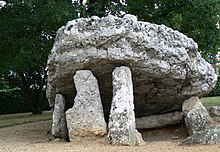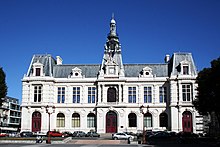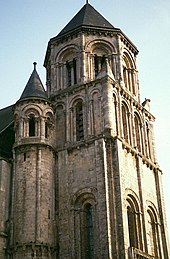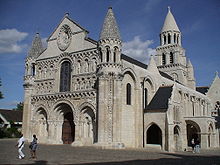Poitiers
| Poitiers | ||
|---|---|---|

|
|
|
| region | Nouvelle-Aquitaine | |
| Department | Vienne | |
| Arrondissement | Poitiers | |
| Canton |
Poitiers-1 (main town) Poitiers-2 (main town) Poitiers-3 (main town) Poitiers-4 (main town) Poitiers-5 (main town) |
|
| Community association | Grand Poitiers | |
| Coordinates | 46 ° 35 ′ N , 0 ° 20 ′ E | |
| height | 65-144 m | |
| surface | 42.11 km 2 | |
| Residents | 88,291 (January 1, 2017) | |
| Population density | 2,097 inhabitants / km 2 | |
| Post Code | 86000 | |
| INSEE code | 86194 | |
| Website | http://www.poitiers.fr/ | |

|
||
Poitiers [ pwat'je ] is the capital of the Vienne department in western France . By 2016, she was also the capital of the then defunct region Poitou-Charentes . It is located on the Clain River and has 88,291 inhabitants (as of January 1, 2017).
Because of their 78 under monument protection standing cultural monuments she was awarded the predicate city of art and history excellent.
history
The town is Celtic in origin, The tribe of pictones founded the Oppidum Lemonum strategically located on a mountain spur between the coincident here rivers Clain and Boivre . Under Roman rule Poitiers was called Pictavium . The city received a Roman urban system with an axilla still visible today, consisting of the Decumanus Maximus (today Grande Rue) and the Cardo (today Rue Arsène Orillard). A Christian community has been attested in Poitiers since the 2nd century, which gained supraregional importance at the latest with the election of Bishop Hilarius (315–368). From 418 at the earliest, Poitiers assumed important political and economic tasks in the Tolosan Empire of the Visigoths .
Not far from the city, these 507 were defeated by the Franks in the Battle of Vouillé . The Franconian Merovingians and Carolingians initiated the construction of numerous churches within the Gallo-Roman walling, as well as on the Old Market and on the banks of the Boivre. In 558, Radegundis of Thuringia, with the support of Chlothar, founded the Sainte-Marie-hors-les-Murs monastery near the city . In the battle of Tours and Poitiers (732) the Franconian ruler Karl Martell stopped the further advance of the Moors into Central Europe . In the 8th century Poitiers became the center of the County of Poitou. With the transfer of the ducal title of Aquitaine to the Counts of Poitou at the end of the 10th century, Poitiers rose to become the capital of the entire southwestern French region between the Loire and the Pyrenees . Poitiers flourished under the rule of Eleanor of Aquitaine , but the conflict with England began when she married Henry II Plantagenet .
In 1356 the French King John the Good was captured in Poitiers after the Battle of Maupertuis between England and France. In 1369 the city was retaken from France. Because Paris was under English occupation at this time, the government of Charles VII was transferred to Poitiers from 1423 to 1436. Here the monarch founded the University of Poitiers in 1431 on the orders of the Pope . From 1527 onwards, several Protestant communities emerged in the Poitou, many of them sought refuge in the city of La Rochelle, which had been converted into a Huguenot fortress . The Edict of Poitiers , which was issued on September 17, 1577, following the Peace of Bergerac , ended the sixth Huguenot War with extensive concessions to the Protestants and essentially confirmed the provisions of the Peace of Saint-Germain of 1570. At that time Poitiers had largely lost its former economic and political importance. However, the city remained the seat of the Archdiocese of Poitiers .
As a result, the city's population grew only slowly and was also declining at times. In the middle of the 16th century Poitiers had around 15,000 inhabitants. The number grew to 25,000 within a century, but then fell to between 17,500 and 18,140 by the second half of the 18th century. In the year of the French Revolution , Poitiers had 21,000 inhabitants, at the beginning of the 19th century this number had fallen to 16,000. The city's industrialization largely failed to materialize in the 19th century. With the appointment of Poitiers as the capital of the Vienne department and the establishment of a garrison under Napoléon Bonaparte , the city was to be given economic impetus, since the university, with a few hundred students, had sunk into insignificance. This policy began to bear fruit in the middle of the 19th century. In 1881 almost 10% of the city's population were members of the military, and there were also new immigrants from the agricultural surrounding area. Around 1900 41% of the workforce worked in small craft and commercial enterprises. Nevertheless, the settlement area grew only slightly. In 1931 around 40,000 people lived in the city.
| Population development | |||||||||||
|---|---|---|---|---|---|---|---|---|---|---|---|
| year | 1936 | 1954 | 1962 | 1968 | 1975 | 1982 | 1990 | 1999 | 2007 | ||
| Residents | 44,269 | 52,681 | 62,178 | 71.129 | 81,313 | 79,350 | 78,894 | 83,448 | 89,253 | ||
coat of arms
Description : In silver, a red lion surrounded by a black border with nine golden balls reaching up to the blue head of the shield with three bar-white golden lilies .
Attractions
Poitiers has prehistoric and ancient cultural monuments such as the Pierre Levée dolmen on the later Roman road to Avaricum (Bourges) or Lugdunum (Lyon) and the remains of one of the largest Roman arenas (early 1st century, originally 150 × 130 m). A dedicatory inscription for the Gallic god Adsmerius was also found here.
From the 12./13. The remains of the former fortifications , known as the "Wall of Eleanor of Aquitaine ", date from the 19th century . Parts of the city wall and the towers built in the Boivre valley have been preserved . The latter currently host facilities of the postal authority.
Another tourist attraction is seven kilometers north of Poitiers which at the time of the Paris industry Cité des Sciences et de l' inspired Futuroscope .
Secular buildings and cultural monuments
The former residence of the Counts of Poitiers has preserved its donjon called “Tour Maubergeon”, established at the end of the Middle Ages . Today it houses the Palace of Justice.
Also preserved the towers remained of the castle of Jean I. de Berry , the castle Clain at the confluence of the Clain and the Boivre.
In the old town, especially in the area of the Rue de la Chaîne, the Place du marché Notre-Dame, the Rue de la Regratterie and the Rue des Vieilles Boucheries, there are numerous beautiful half-timbered houses .
Among the so-called "Hôtels Particuliers", i.e. the former city palaces of the upper middle class, the Hôtel Fumé and the Hôtel Berthelot on Rue de la Chaîne, where the university's history and humanities faculty is currently located, as well as the Hotel du Puyarreau.
Also worth seeing are the Hôtel de Ville de Poitiers , the town hall, the statue “Notre-Dame des Dunes” and the copy of the Statue of Liberty , which was erected in memory of General Jean-Baptiste Berton at the former location of the pillory where the general was was guillotined in 1822 .
Sacred buildings
The early Christian baptistery of St. Jean (in the core 6th century with possibly older predecessors), one of the oldest preserved sacred buildings in France, the Romanesque churches of St. Hilaire-le-Grand and Sainte-Radegonde, which are the presence of outstanding personalities, are of art historical importance in Poitiers, thanks to the holy Doctor of the Church Hilarius of Poitiers and Saint Radegundis , the wife of Chlothar I , as well as the Church of Notre-Dame la Grande .
- The date of origin of the baptismal font at the later Saint-Jean Baptistery , originally set up in a Roman house, has been dated to the 5th century according to new studies and dendrochronological data. The first construction phase with the rectangular hall of today's baptistery could, according to the appearance of the complex, belong to the 6th century.
- The basilica Saint-Hilaire-le-Grand of the monastery of Saint-Hilaire-de-Poitiers (11th century, heavily restored) can be assigned to the Romanesque period on the site of the oratory and the tomb of St. Hilary of Poitiers († 367 ). It is located on the French Camino de Santiago Via Turonensis and is part of the UNESCO World Heritage “Camino de Santiago in France”.
- The Ste. Radegonde (11th / 13th century) is built in the Romanesque style. It replaced a church built in the 6th century at the instigation of St. Radegundis († 587). The abbey of Sainte-Croix , also founded on the initiative of Radegundis, had to give way for the most part to the construction of a road in the 19th century.
- Notre-Dame la Grande , the late Romanesque church (12th century) is famous for its exceptionally rich plastic facade decoration.
- The Cathedral of St. Pierre (12th / 13th century) was built as a hall church based on the Poitevinian Romanesque style and is a rather rare example of this type of building in Gothic. The easternmost yokes of the cathedral are Romanesque, but they went Master builder switched to Gothic style as construction progressed.
- The former monastery church of St. Jean de Montierneuf (11th century) also shows the transition from Romanesque (base) to Gothic (choir head).
traffic
The Poitiers-Biard Airport is located west of Poitiers.
In the west of the city, west of the airport, the Autoroute A10 ( L'Aquitaine ) runs, which is part of the European route 5 in this area . There are two access points (29: Poitiers-Nord and 30: Poitiers-Sud).
The Poitiers train station, built in 1851, is on the Paris – Bordeaux line .
Culture
Town twinning
-
 Marburg an der Lahn , Germany , since 1961
Marburg an der Lahn , Germany , since 1961 -
 Iași , Romania , since 1969
Iași , Romania , since 1969 -
 Yaroslavl , Russia , since 1970
Yaroslavl , Russia , since 1970 -
 Lafayette , USA , since 1975
Lafayette , USA , since 1975 -
 Coimbra , Portugal , since 1979
Coimbra , Portugal , since 1979 -
 Northampton , UK , since 1979
Northampton , UK , since 1979 -
 Moundou , Chad , since 1990
Moundou , Chad , since 1990
School partnerships
- An annual student exchange between the Lycée du bois d'amour and the Martin Luther School (Marburg) has been taking place successfully for many years in the twin town of Marburg . In addition, pupils of the first foreign language at the Martin Luther School meet exchange partners from the collège Rabelais in Poitiers every two years .
- For many years the Parler-Gymnasium , Schwäbisch Gmünd , had an intensive exchange with Poitiers. The Collège Jardin des Plantes in Poitiers has been running regular exchange programs with the partner school Hochheider Weg in Oldenburg since 1975 .
- The Lycée Camille Guérin and the grammar school Philippinum Marburg have been partners since 1967. There were annual exchange trips between students of the Seconde (Camille Guérin) and the 10th grade (Philippinum). In the meantime, this exchange no longer takes place.
- The Collège Camille Guérin and the Gymnasium Cologne-Rodenkirchen have been exchanging information every year for more than 15 years.
- The Collège Henri IV and the Katharinen-Gymnasium Ingolstadt have been running student exchanges for many years.
- The Collège La Providence and the Lycée Isaac de l'étoile hold an exchange every year with the Archbishop's School Marienberg , Neuss .
Sports
The ITF Poitiers, a tennis tournament of the ITF Women's Circuit , takes place in Poitiers.
education
The University of Poitiers was founded in 1431 by Charles VII. Poitiers has the second oldest university in France. Thinkers like François Rabelais , René Descartes and Francis Bacon attended the university. Today Poitiers is one of the largest student cities in France - the city has more students per inhabitant than any other French university city.
- Universities
The universities of Poitiers are:
- University of Poitiers
- École Nationale Supérieure d'Ingénieurs de Poitiers (ENSIP)
- ESCEM
- IAE from Poitiers
- ENSMA Ecole Nationale Supérieure de Mécanique et d'Aérotechnique
Personalities
Sons and daughters
- Hilary of Poitiers (around 315–367), bishop and doctor of the church
- Emmeram von Regensburg (? –652), bishop and martyr
- Gilbert von Poitiers (~ 1080–1145), scholastic philosopher and theologian
- Eleanor of Aquitaine (around 1122 - 1204), Duchess of Aquitaine, Queen of France and England
- Alix Petronilla of Aquitaine (1125–1151), Countess of Vermandois, sister of Eleanor of Aquitaine
- Philippe Goibaud-Dubois (1626–1694), translator and member of the Académie française
- Petrus Sabatier (1682–1742), Benedictine, editor of the Vetus Latina
- Pierre Roll (1787-1851), composer
- Arthur Ranc (1831–1908), politician, journalist and writer
- Léon Bazile Perrault (1832–1908), painter
- Louis Vierne (1870–1937), organist and composer
- Camille Guérin (1872–1961), veterinarian, bacteriologist and immunologist
- Abel Bonnard (1883–1968), poet and novelist
- Pierre Dangeard (1895–1970), botanist
- Louis Dangeard (1898–1987), geologist and oceanographer
- Raymond Gaillard (1904–1973), entrepreneur and racing car driver
- Pierre Petit (1922–2000), composer
- Odile Caradec (* 1925), poet
- Michel Foucault (1926–1984), philosopher
- Marc Augé (* 1935), ethnologist and anthropologist
- Joël Robuchon (1945–2018), cook and restaurateur
- Jean-Pierre Raffarin (* 1948), politician (UMP)
- Catherine Guy-Quint (* 1949), politician
- Jean-Pierre Abelin (* 1950), politician and member of the National Assembly
- Jean-Pierre Thiollet (* 1956), writer
- Franck Proust (* 1963), politician
- Monique Éwanjé-Épée (* 1967), hurdler
- Cyril Pedrosa (* 1972), comic artist
- Alexandre Lacroix (* 1975), writer, essayist and journalist
- Brian Joubert (* 1984), figure skater
- Benjamin Lavernhe (* 1984), actor
- Simon Pagenaud (* 1984), racing driver
- Romain Édouard (* 1990), chess grandmaster
- Marine Partaud (* 1994), tennis player
People with a relationship to the city
- Radegunde von Thuringia (518 / 20–587), Queen of the Franks, saint, died in Poitiers and is buried here
- Agnes of Poitiers († 588), foster daughter and friend of Radegundes, abbess of Sainte-Croix, saint
- Venantius Honorius Clementianus Fortunatus (around 535 – around 609), poet and bishop of Poitiers
- Karl Lashley (1890–1958), American psychologist, died unexpectedly while on vacation in Poitiers
literature
- Brigitte Boissavit-Camus: Poitiers. In: Reallexikon der Germanischen Altertumskunde (RGA). 2nd Edition. Volume 23, Walter de Gruyter, Berlin / New York 2003, ISBN 3-11-017535-5 , pp. 243-246.
- Ulrich Nonn : Tours and Poitiers. In: Reallexikon der Germanischen Altertumskunde (RGA). 2nd Edition. Volume 31, Walter de Gruyter, Berlin / New York 2006, ISBN 3-11-018386-2 , pp. 106-108.
Web links
Individual evidence
- ^ A b c Alfred Pletsch, Hansjörg Dongus, Henrik Uterwedde: France - geography, history, economy, politics . In: Werner Storkebaum (Ed.): Scientific country customers . Scientific Book Society Darmstadt, Darmstadt 1997, ISBN 3-534-11691-7 , p. 136 ff .
- ^ INSEE: Population of Poitiers 2007









